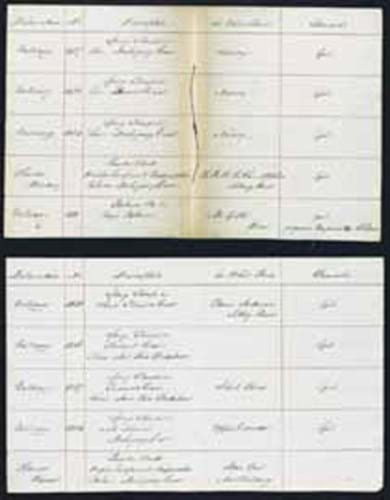
A particularly good example turned up at Bonhams Bond Street recently when a man brought in what the auctioneers described as a "large fruit box" filled with an assortment of papers and trade cards. The box also contained a folder which the owner knew to be an interesting document - 17 sheets of lined paper recording in sepia ink the details of 108 royal clocks giving their maker, number, description, location and remarks, as shown in our illustration right.
The manuscript was titled Catalogue of her Majesty's Clocks in Buckingham Palace, April 1854 CF. The CF stands for Charles Frodsham who received the warrant to act as Superintendent and Keeper of Her Majesty's Clocks at Buckingham Palace in Ordinary in that same year and month. The following year he went on to become Master of the Clockmaker's Company.
It seems most likely, therefore, that the manuscript was Frodsham's own personal record of the royal clocks under his care in his new post. An added bonus was the discovery of a selection of Charles Frodsham Ltd watch papers and business cards covering the period 1936-52. The unused state of the cards and papers suggests that their owner was personally involved with Frodshams, although whether they entered the larger ephemera collection with the manuscript or separately is not clear.
While interesting in its own right as a royal record, the manuscript catalogue has the added dimension of being a highly respected mid-19th century clockmaker's opinion of the work produced as royal commissions by his forebears. The firm of Vulliamy, whom Frodsham succeeded as superintendent of the royal clocks (and whose work is much admired and collected today), seems to have come in for the warmest admiration. Frodsham only affords six of the 108 clocks that he surveyed the accolade of first class work and five of those are by Vulliamy which, interestingly, Frodsham took over in the same year.
Bonhams decided to to offer the bulk of the ephemera collection in a book auction but removed the manuscript and Frodsham papers and offered them separately in their clock auction on December 15 with an estimate of £500-700.
"It was a difficult thing to put a value on," said their clock specialist James Stratton, although he had felt the collection would have crossover appeal.
Potentially, there could have been a wide range of prospective purchasers from those with general horological or royal memorabilia interests to more specific candidates such as the Clockmakers Company or Buckingham Palace. One other obvious candidate was the firm of Charles Frodsham itself, which still exists. And it was Frodsham's who acquired the lot on the day, bidding in the room against the telephone to £1600 plus 19.5 per cent premium.
Talking after the sale, Richard Stenning of Frodshams said that they did not know how the 150-year-old piece of ephemera became separated from the company: "We were obviously delighted to find it was still extant and that we were able to repatriate it to the firm's records."




